数学建模实验报告第十一章最短路问答
- 格式:doc
- 大小:73.92 KB
- 文档页数:18

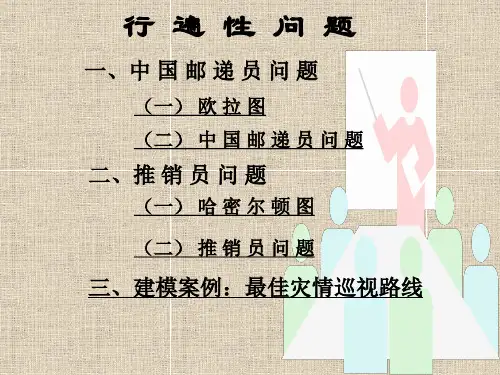
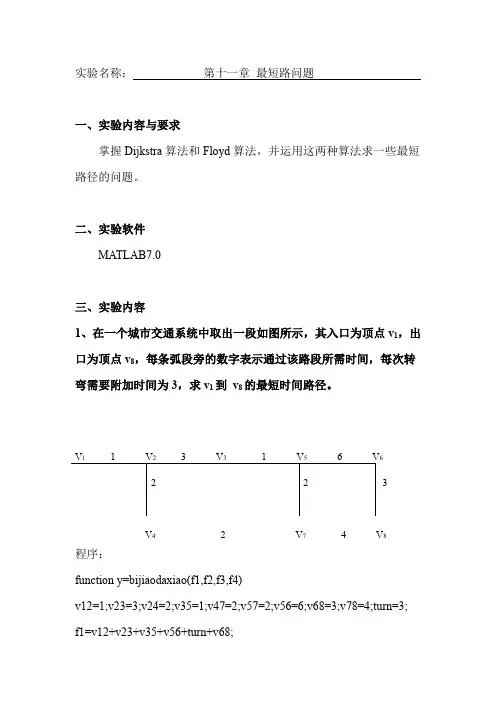
实验名称:第十一章最短路问题一、实验内容与要求掌握Dijkstra算法和Floyd算法,并运用这两种算法求一些最短路径的问题。
二、实验软件MATLAB7.0三、实验内容1、在一个城市交通系统中取出一段如图所示,其入口为顶点v1,出口为顶点v8,每条弧段旁的数字表示通过该路段所需时间,每次转弯需要附加时间为3,求v1到v8的最短时间路径。
63V4 2 V7 4 V8程序:function y=bijiaodaxiao(f1,f2,f3,f4)v12=1;v23=3;v24=2;v35=1;v47=2;v57=2;v56=6;v68=3;v78=4;turn=3; f1=v12+v23+v35+v56+turn+v68;f2=v12+v23+v35+turn+v57+turn+v78;f3=v12+turn+v24+turn+v47+v78;f4=v12+turn+v24+v47+turn+v57+turn+v56+turn+v68; min=f1;if f2<minmin=f2;endif f3<minmin=f3;endif f4<minmin=f4;endminf1f2f3f4实验结果:v1到v8的最短时间路径为15,路径为1-2-4-7-8.2、求如图所示中每一结点到其他结点的最短路。
V110 V3V59 V6function[D,R]=floyd(a)n=size(a,1);D=afor i=1:nfor j=1:nR(i,j)=j;endendRfor k=1:nfor i=1:nfor j=1:nif D(i,k)+D(k,j)<D(i,j)D(i,j)=D(i,k)+D(k,j);R(i,j)=R(i,k);endendendkDRend程序:>> a=[0 3 10 inf inf inf inf inf;3 0 inf 5 inf inf inf inf;10 inf 0 6 inf inf inf inf;inf 5 6 0 4 inf 10 inf ;inf inf inf 4 0 9 5 inf ;inf inf inf inf 9 0 3 4;inf inf inf 10 5 3 0 6;inf inf inf inf inf 4 6 0;];[D,R]=floyd(a)实验结果:D =0 3 10 Inf Inf Inf Inf Inf3 0 Inf 5 Inf Inf Inf Inf10 Inf 0 6 Inf Inf Inf InfInf 5 6 0 4 Inf 10 InfInf Inf Inf 4 0 9 5 InfInf Inf Inf Inf 9 0 3 4Inf Inf Inf 10 5 3 0 6Inf Inf Inf Inf Inf 4 6 0R =1 2 3 4 5 6 7 81 2 3 4 5 6 7 81 2 3 4 5 6 7 81 2 3 4 5 6 7 81 2 3 4 5 6 7 81 2 3 4 5 6 7 81 2 3 4 5 6 7 81 2 3 4 5 6 7 8k =1D =0 3 10 Inf Inf Inf Inf Inf3 0 13 5 Inf Inf Inf Inf10 13 0 6 Inf Inf Inf InfInf 5 6 0 4 Inf 10 InfInf Inf Inf 4 0 9 5 InfInf Inf Inf Inf 9 0 3 4Inf Inf Inf 10 5 3 0 6Inf Inf Inf Inf Inf 4 6 0R =1 2 3 4 5 6 7 81 2 1 4 5 6 7 81 1 3 4 5 6 7 81 2 3 4 5 6 7 81 2 3 4 5 6 7 81 2 3 4 5 6 7 81 2 3 4 5 6 7 81 2 3 4 5 6 7 8 k =2D =0 3 10 8 Inf Inf Inf Inf3 0 13 5 Inf Inf Inf Inf10 13 0 6 Inf Inf Inf Inf8 5 6 0 4 Inf 10 InfInf Inf Inf 4 0 9 5 InfInf Inf Inf Inf 9 0 3 4Inf Inf Inf 10 5 3 0 6Inf Inf Inf Inf Inf 4 6 0R =1 2 3 2 5 6 7 81 2 1 4 5 6 7 81 1 3 4 5 6 7 82 234567 81 2 3 4 5 6 7 81 2 3 4 5 6 7 81 2 3 4 5 6 7 81 2 3 4 5 6 7 8 k =3D =0 3 10 8 Inf Inf Inf Inf3 0 13 5 Inf Inf Inf Inf10 13 0 6 Inf Inf Inf Inf8 5 6 0 4 Inf 10 InfInf Inf Inf 4 0 9 5 InfInf Inf Inf Inf 9 0 3 4Inf Inf Inf 10 5 3 0 6Inf Inf Inf Inf Inf 4 6 0R =1 2 3 2 5 6 7 81 2 1 4 5 6 7 81 1 3 4 5 6 7 82 234567 81 2 3 4 5 6 7 81 2 3 4 5 6 7 81 2 3 4 5 6 7 81 2 3 4 5 6 7 8k =4D =0 3 10 8 12 Inf 18 Inf3 0 11 5 9 Inf 15 Inf10 11 0 6 10 Inf 16 Inf8 5 6 0 4 Inf 10 Inf12 9 10 4 0 9 5 InfInf Inf Inf Inf 9 0 3 418 15 16 10 5 3 0 6Inf Inf Inf Inf Inf 4 6 0R =1 2 3 2 2 6 2 81 2 4 4 4 6 4 81 4 3 4 4 6 4 82 234567 84 4 4 4567 81 2 3 4 5 6 7 84 4 4 4567 81 2 3 4 5 6 7 8 k =5D =0 3 10 8 12 21 17 Inf3 0 11 5 9 18 14 Inf10 11 0 6 10 19 15 Inf8 5 6 0 4 13 9 Inf12 9 10 4 0 9 5 Inf21 18 19 13 9 0 3 417 14 15 9 5 3 0 6Inf Inf Inf Inf Inf 4 6 0R =1 2 3 2 2 2 2 81 2 4 4 4 4 4 81 4 3 4 4 4 4 82 2345 5 5 84 4 4 4567 85 5 5 5 567 85 5 5 5 567 81 2 3 4 5 6 7 8 k =6D =0 3 10 8 12 21 17 253 0 11 5 9 18 14 2210 11 0 6 10 19 15 238 5 6 0 4 13 9 1712 9 10 4 0 9 5 1321 18 19 13 9 0 3 417 14 15 9 5 3 0 625 22 23 17 13 4 6 0 R =1 2 3 2 2 2 2 21 2 4 4 4 4 4 41 4 3 4 4 4 4 42 2345 5 5 54 4 4 4567 65 5 5 5 567 85 5 5 5 567 86 6 6 6 6 678 k =7D =0 3 10 8 12 20 17 233 0 11 5 9 17 14 2010 11 0 6 10 18 15 218 5 6 0 4 12 9 1512 9 10 4 0 8 5 1120 17 18 12 8 0 3 417 14 15 9 5 3 0 623 20 21 15 11 4 6 0 R =1 2 3 2 2 2 2 21 2 4 4 4 4 4 41 4 3 4 4 4 4 42 2345 5 5 54 4 4 45 7 7 77 7 7 7 7 6 7 85 5 5 5 567 87 7 7 7 7 6 7 8 k =8D =0 3 10 8 12 20 17 233 0 11 5 9 17 14 2010 11 0 6 10 18 15 218 5 6 0 4 12 9 1512 9 10 4 0 8 5 1120 17 18 12 8 0 3 417 14 15 9 5 3 0 623 20 21 15 11 4 6 0R =1 2 3 2 2 2 2 21 2 4 4 4 4 4 41 4 3 4 4 4 4 42 2345 5 5 54 4 4 45 7 7 77 7 7 7 7 6 7 85 5 5 5 567 87 7 7 7 7 6 7 8D =0 3 10 8 12 20 17 233 0 11 5 9 17 14 2010 11 0 6 10 18 15 218 5 6 0 4 12 9 1512 9 10 4 0 8 5 1120 17 18 12 8 0 3 417 14 15 9 5 3 0 623 20 21 15 11 4 6 0 R =1 2 3 2 2 2 2 21 2 4 4 4 4 4 41 4 3 4 4 4 4 42 2345 5 5 54 4 4 45 7 7 77 7 7 7 7 6 7 85 5 5 5 567 87 7 7 7 7 6 7 8四、实验体会。
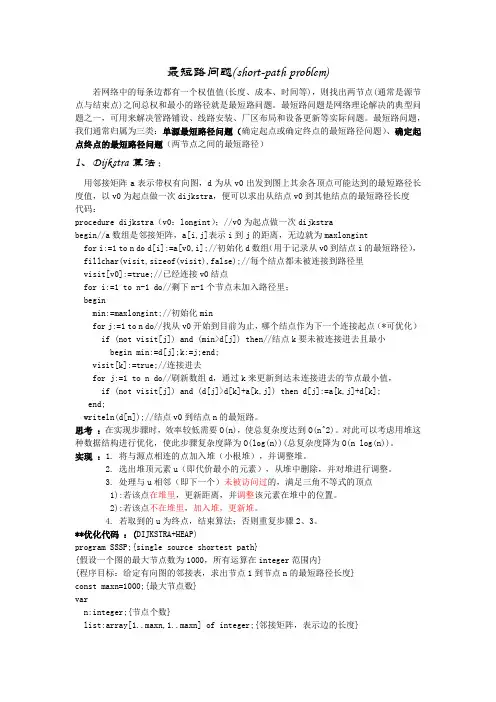
最短路问题(short-path problem)若网络中的每条边都有一个权值值(长度、成本、时间等),则找出两节点(通常是源节点与结束点)之间总权和最小的路径就是最短路问题。
最短路问题是网络理论解决的典型问题之一,可用来解决管路铺设、线路安装、厂区布局和设备更新等实际问题。
最短路问题,我们通常归属为三类:单源最短路径问题(确定起点或确定终点的最短路径问题)、确定起点终点的最短路径问题(两节点之间的最短路径)1、Dijkstra算法:用邻接矩阵a表示带权有向图,d为从v0出发到图上其余各顶点可能达到的最短路径长度值,以v0为起点做一次dijkstra,便可以求出从结点v0到其他结点的最短路径长度代码:procedure dijkstra(v0:longint);//v0为起点做一次dijkstrabegin//a数组是邻接矩阵,a[i,j]表示i到j的距离,无边就为maxlongintfor i:=1 to n do d[i]:=a[v0,i];//初始化d数组(用于记录从v0到结点i的最短路径), fillchar(visit,sizeof(visit),false);//每个结点都未被连接到路径里visit[v0]:=true;//已经连接v0结点for i:=1 to n-1 do//剩下n-1个节点未加入路径里;beginmin:=maxlongint;//初始化minfor j:=1 to n do//找从v0开始到目前为止,哪个结点作为下一个连接起点(*可优化) if (not visit[j]) and (min>d[j]) then//结点k要未被连接进去且最小begin min:=d[j];k:=j;end;visit[k]:=true;//连接进去for j:=1 to n do//刷新数组d,通过k来更新到达未连接进去的节点最小值,if (not visit[j]) and (d[j]>d[k]+a[k,j]) then d[j]:=a[k,j]+d[k];end;writeln(d[n]);//结点v0到结点n的最短路。
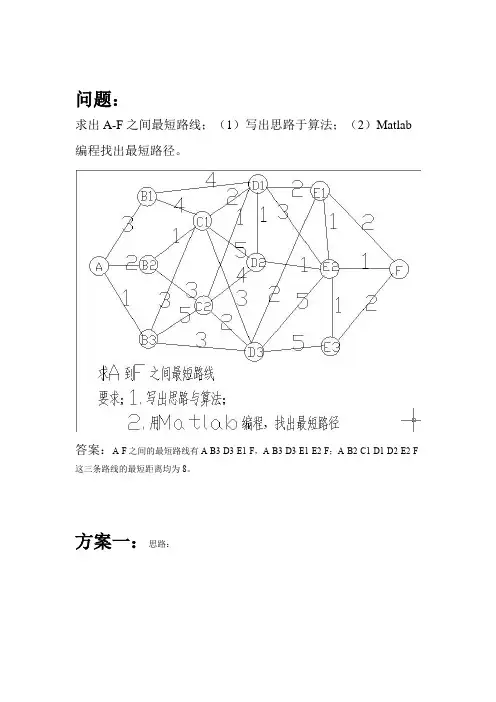
问题:求出A-F之间最短路线;(1)写出思路于算法;(2)Matlab 编程找出最短路径。
答案:A-F之间的最短路线有A-B3-D3-E1-F,A-B3-D3-E1-E2-F;A-B2-C1-D1-D2-E2-F 这三条路线的最短距离均为8。
方案一:思路:对于是否返回的分析:如图可以看出只有B端才能跨越C端的点直接到达D端的,其余的各端点都是必须按照字母顺序一路下来。
若如D端返回到C端或B端这是不可能的,因为这样无疑增加了路程,如图可以看出C端的点能到达D端的各个点,所以要求的直接命中想到达的该点;而D端出发去到E端后有图可以看出不可能再返回D端了,因为这只会增加路线的长度,而且E 端的各点是相通的,也没必要再返回D端;同样B端到达C端或D端的,因为B2,B2到能直接到达C端的各点,只有B1只能到达C1,但B1它到D1的距离和B1点到C1的距离同样为4但也不可能经过C1后返回B端的,因为C1也是联系D端的各点,而且你要返回B 段端,还不如在A端的时候就选择好一个理想的B点,这样距离会更加短。
所以不能进行返回。
如图将我们本来所需要的的路线分成两半,以D字母的为中间端。
后半部分:后半部分主要由D端连接到E端最后才连接到F端的,同时D端无法越过E端直接连接到F端。
更为重要的是前半部分,也必须要经过D端才能与F端相接,所以构成他们之间的枢纽定在D端是最好不过的。
首先的是先分析D端的三个点D1,D2,D3分别到点F的最短距离。
一、已经从D端出发去到E端后有图可以看出不可能再返回D端了,因为这只会增加路线的长度,而且E端的各点是相通的,也没必要再返回D端;二、由图可以看出E端到点F最好的路线是E2-F距离为1,除E2外的E1,E3他们到F点的方式(E1-F, E1-E2-F ,E3-F ,E3-E2-F)的距离均为2;所以如果能先到达E2则可以只考虑E2到F这条路线。
若先到达了E1,或E3、则这路线的最短路径必定变化为两条。
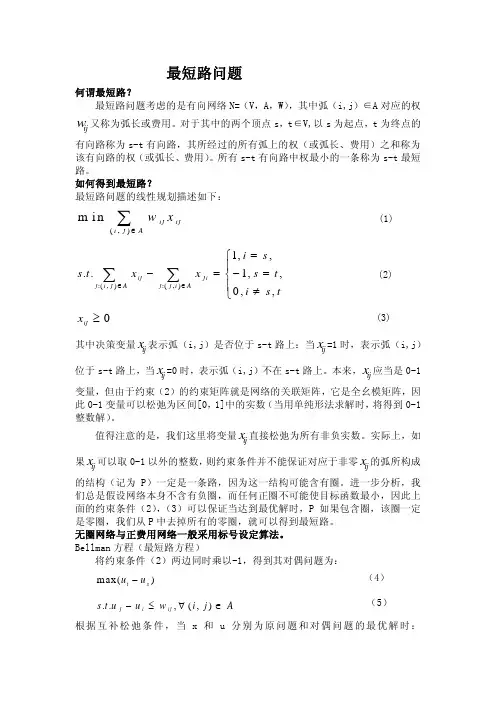
最短路问题何谓最短路?最短路问题考虑的是有向网络N=(V,A,W),其中弧(i,j)∈A 对应的权又称为弧长或费用。
对于其中的两个顶点s,t∈V,以s 为起点,t 为终点的有向路称为s-t 有向路,其所经过的所有弧上的权(或弧长、费用)之和称为该有向路的权(或弧长、费用)。
所有s-t 有向路中权最小的一条称为s-t 最短路。
ij w 如何得到最短路?最短路问题的线性规划描述如下:(,)m i ni j i j i j A w x ∈∑ (1):(,):(,)1,,..1,,0,,ij ji j i j A j j i A i s s t x x s i s t ∈∈=⎧⎪t −=−=⎨⎪≠⎩∑∑ (2) 0ij x ≥ (3) 其中决策变量表示弧(i,j)是否位于s-t 路上:当=1时,表示弧(i,j)位于s-t 路上,当=0时,表示弧(i,j)不在s-t 路上。
本来,应当是0-1变量,但由于约束(2)的约束矩阵就是网络的关联矩阵,它是全幺模矩阵,因此0-1变量可以松弛为区间[0,1]中的实数(当用单纯形法求解时,将得到0-1整数解)。
ij x ij x ij x ij x 值得注意的是,我们这里将变量直接松弛为所有非负实数。
实际上,如果可以取0-1以外的整数,则约束条件并不能保证对应于非零的弧所构成的结构(记为P)一定是一条路,因为这一结构可能含有圈。
进一步分析,我们总是假设网络本身不含有负圈,而任何正圈不可能使目标函数最小,因此上面的约束条件(2),(3)可以保证当达到最优解时,P 如果包含圈,该圈一定是零圈,我们从P 中去掉所有的零圈,就可以得到最短路。
ij x ij x ij x 无圈网络与正费用网络一般采用标号设定算法。
Bellman 方程(最短路方程)将约束条件(2)两边同时乘以-1,得到其对偶问题为:m ax()t s u u − (4)..,(,)j i ij s t u u w i j A −≤∀∈ (5)根据互补松弛条件,当x 和u 分别为原问题和对偶问题的最优解时:()0,(,i j j i i j )x u u w i j −−=∀∈A (6) 因此,当某弧(i,j)位于最短路上时,即对应的变量>0时,一定有ij x j i i u u w −=j 。
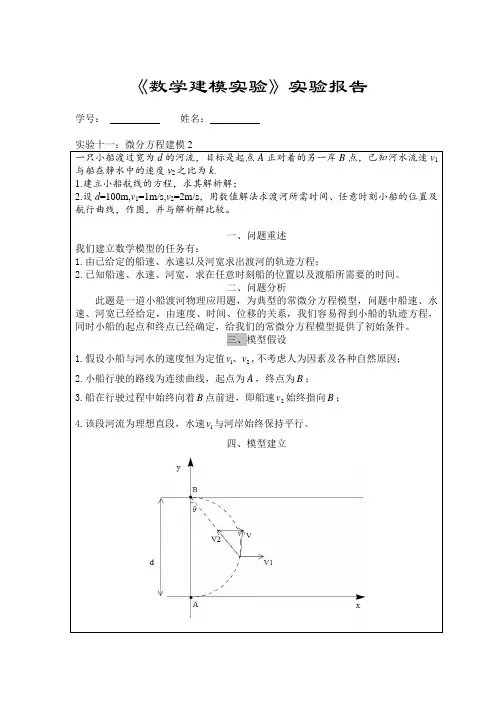
《数学建模实验》实验报告学号: 姓名:一只小船渡过宽为d 的河流,目标是起点A 正对着的另一岸B 点,已知河水流速v 1与船在静水中的速度v 2之比为k .1.建立小船航线的方程,求其解析解;2.设d =100m,v 1=1m/s,v 2=2m/s ,用数值解法求渡河所需时间、任意时刻小船的位置及航行曲线,作图,并与解析解比较。
一、问题重述我们建立数学模型的任务有:1.由已给定的船速、水速以及河宽求出渡河的轨迹方程;2.已知船速、水速、河宽,求在任意时刻船的位置以及渡船所需要的时间。
二、问题分析此题是一道小船渡河物理应用题,为典型的常微分方程模型,问题中船速、水速、河宽已经给定,由速度、时间、位移的关系,我们容易得到小船的轨迹方程,同时小船的起点和终点已经确定,给我们的常微分方程模型提供了初始条件。
三、模型假设1.假设小船与河水的速度恒为定值21v v 、,不考虑人为因素及各种自然原因;2.小船行驶的路线为连续曲线,起点为A ,终点为B ;3.船在行驶过程中始终向着B 点前进,即船速2v 始终指向B ;4.该段河流为理想直段,水速1v 与河岸始终保持平行。
四、模型建立68.7000 -0.0000 100.000068.8000 -0.0000 100.000068.9000 -0.0000 100.000069.0000 -0.0000 100.0000我们看到,在=t 66.6s 时,小船到达对岸B 。
接下来我们给出小船的t y t x --,图像以及小船的轨迹以及与解析法的比较图像如下图:由第三个图,我们可以看出数值解与解析解图像几乎重合,差别不大。
六、附录:(1)建立m文件boat1.mfunction dx=boat1(t,x)v1=1;v2=2;d=100;dx=[v1-v2*x(1)/sqrt(x(1)^2+(d-x(2))^2);v2*(d-x(2))/sqrt((d-x(2))^2+x(1)^ 2)];end(2)主程序如下:tt=0:0.1:100;x0=[0,0];[t,x]=ode23s(@boat1,tt,x0);%用龙格-库塔方法计算微分;[t,x]figure(1)plot(t,x),gridtitle('xy分位移-时间曲线图');legend('x-t','y-t')figure(2)plot(x(:,1),x(:,2))title('小船轨迹图');Y=0:0.1:100;d=100;v1=1;v2=2;k=v1/v2;X=0.5*d*((1-Y./d).^(1-k)-(1-Y./d).^(1+k));figure(3)plot(X,Y,'r',x(1:100:end,1),x(1:100:end,2),'g')。
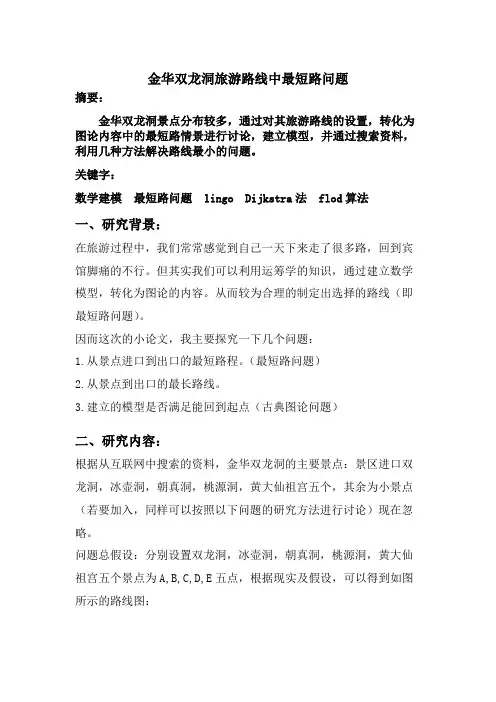
金华双龙洞旅游路线中最短路问题摘要:金华双龙洞景点分布较多,通过对其旅游路线的设置,转化为图论内容中的最短路情景进行讨论,建立模型,并通过搜索资料,利用几种方法解决路线最小的问题。
关键字:数学建模最短路问题 lingo Dijkstra法 flod算法一、研究背景:在旅游过程中,我们常常感觉到自己一天下来走了很多路,回到宾馆脚痛的不行。
但其实我们可以利用运筹学的知识,通过建立数学模型,转化为图论的内容。
从而较为合理的制定出选择的路线(即最短路问题)。
因而这次的小论文,我主要探究一下几个问题:1.从景点进口到出口的最短路程。
(最短路问题)2.从景点到出口的最长路线。
3.建立的模型是否满足能回到起点(古典图论问题)二、研究内容:根据从互联网中搜索的资料,金华双龙洞的主要景点:景区进口双龙洞,冰壶洞,朝真洞,桃源洞,黄大仙祖宫五个,其余为小景点(若要加入,同样可以按照以下问题的研究方法进行讨论)现在忽略。
问题总假设:分别设置双龙洞,冰壶洞,朝真洞,桃源洞,黄大仙祖宫五个景点为A,B,C,D,E五点,根据现实及假设,可以得到如图所示的路线图:再利用用Dijkstra算法求解无负权网络的最短路。
同时也可以利用此法算出最长路程。
问题一的解决:以A为景点出口,E为出口。
故A点标号为P(a)=0 给其余所有的T标号T(i)=+∞考虑与A相邻的两个顶点BC,两个顶点为T标号,故修改这两个点的标号为:T(b)=min[T(b),P(a)+l12]=min[+∞,0+3]=3T(c)=min[T(c),P(a)+l13]=min[+∞,0+2]=2比较所有T标号,T(c)最小,所以令P(c)=2再考察(C,B)(C,D)(C,E)的端点:同理可得T(b)=6 T(d)=6.8 T(e)=10.2(显然已经到终点但还需要看看其余路线长短)故又令P(b)=6.综合分析只有一条线路即A→C→B→D→E 此时总路程为2+4+3+8.4=16.4>10.2所以,最短路程为A→C→E。
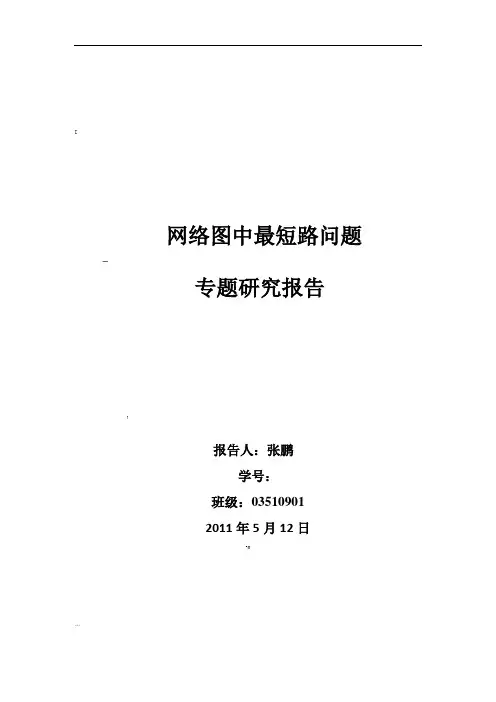
[网络图中最短路问题—专题研究报告!报告人:张鹏学号:班级:035109012011年5月12日%…网络图中最短路问题…【问题导引】网络分析在电子导航、交通旅游、城市规划以及电力、通讯等各种管网、管线的布局设计中发挥了重要作用。
而最短路问题是网络分析中最基本、最关键的问题。
最短路径不仅指一般地理意义上的距离最短,还可以引申到其他的度量,如时间,费用等等。
这些都可以抽像为在图中找出任意两点间的一条通路,使这条通路上的权值和最小。
最短路问题作为图与网络技术研究的一个经典问题,在工程规划、地理信息系统、通信和军事运筹学等领域有十分广泛的应用。
举例如下:}【案例一】:如图的交通网络,图中的点表示交通节点,每条边表示两个节点间的一条通路,边上的数字表示路段的长度,有向边表示单行道,无向边表示可双向行驶。
若有一批货物要从1号顶点运往11号顶点,问运货车应沿哪条线路行驶,才能最快地到达目的地【案例分析与建模】:这是实际生活中经常遇到的一类问题,首先对该问题做如下假设以便抽象为数学模型。
假设一:各路段路况相同,车辆在各路段以相同的速度行驶。
~假设二:各路段均一路畅通,即不存在堵车问题。
在以上两种假设的前提下,此问题即转化为在图中选一条从节点1到节点11的通路,使得路径总长度最短,即典型的最短路问题模型。
将图抽象为距离矩阵表示,即可建立数学模型,设计算法求解。
【算法设计】:对于最短路模型,传统的Dijkstra算法和floyd算法为两种有效的求解方法。
利用Dijkstra算法求解案例一中的问题。
!算法思路:采用标号作业法,每次迭代产生一个永久标号, 从而生长一颗以v0为根的最短路树,在这棵树上每个顶点与根节点之间的路径皆为最短路径。
S: 具有永久标号的顶点集;l(v): v的标记;f(v):v的父顶点,用以确定最短路径;"输入:输入加权图的带权邻接矩阵w=[w(vi,vj)]nxm.1)初始化:令l(v0)=0,S=Ø; v≠v0 ,l(v)= ;2)更新l(v), f(v):寻找不在S中的顶点u,使l(u)为最小.把u加入到S中,然后对所有不在S中的顶点v,如l(v)>l(u)+w(u,v),则更新l(v),f(v), 即l(v)l(u)+w(u,v),f(v)u;3)重复步骤2), 直到所有顶点都在S中为止。
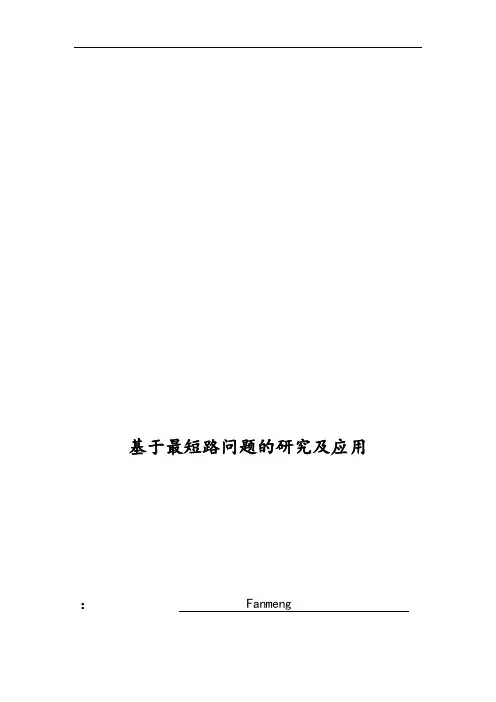
基于最短路问题的研究及应用: Fanmeng学号:指导老师:摘要最短路问题是图论中的一大问题,对最短路的研究在数学建模和实际生活中具有很重要的实际意义,介绍最短路问题的定义及这类问题的解决办法Dijkstra算法,并且能够在水渠修建实例运用到此数学建模的方法,为我们解决这类图论问题提供了基本思路与方法。
关键字数学建模最短路问题 Dijkstra算法水渠修建。
目录第一章.研究背景 (1)第二章.理论基础 (2)2.1 定义 (2)2.2 单源最短路问题Dijkstra求解: (2)2.2.1 局限性 (2)2.2.2 Dijkstra算法求解步骤 (2)2.2.3 时间复杂度 (2)2.3 简单样例 (3)第三章.应用实例 (4)3.1 题目描述 (4)3.2 问题分析 (4)3.3符号说明 (5)3.4 模型假设 (5)3.5模型建立与求解 (5)3.5.1模型选用 (5)3.5.2模型应用及求解 (5)3.6模型评价 (5)第四章. 参考文献 (6)第五章.附录 (7)第一章.研究背景在现实生活中中,我们经常会遇到图类问题,图是一种有顶点和边组成,顶点代表对象,在示意图中我们经常使用点或者原来表示,边表示的是两个对象之间的连接关系,在示意图中,我们使用连接两点G点直接按的下端来表示。
顶点的集合是V,边的集合是E的图记为G[V,E] ,连接两点u和v的边用e(u,v)表示[1]。
最短问题是图论中的基础问题,也是解决图类问题的有效办法之一,在数学建模中会经常遇到,通常会把一个实际问题抽象成一个图,然后来进行求的接任意两点之间的最短距离。
因此掌握最短路问题具有很重要的意义。
第二章.理论基础2.1 定义最短路问题(short-path problem ):若网络中的每条边都有一个数值(长度、成本、时间等),则找出两节点,(通常是源节点和目标节点)之间总权和最小的路径就是最短路问题。
最短路问题是网络理论解决的典型问题之一,可用来解决管道铺设,线路安装,厂区布局和设备更新等实际问题[2]。
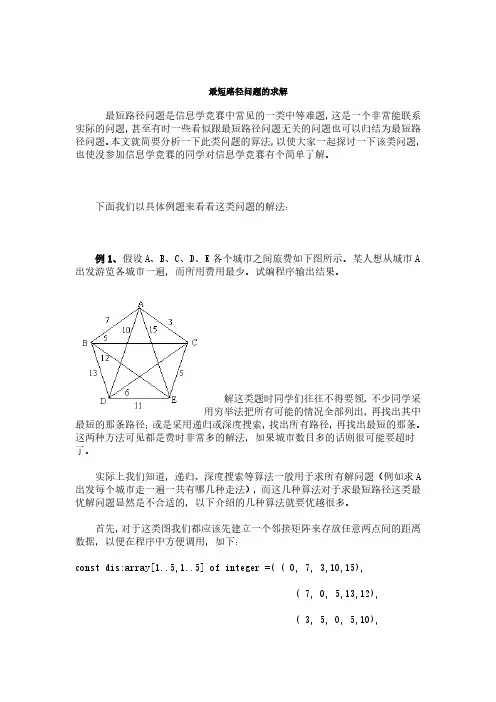
最短路径问题的求解最短路径问题是信息学竞赛中常见的一类中等难题,这是一个非常能联系实际的问题,甚至有时一些看似跟最短路径问题无关的问题也可以归结为最短路径问题。
本文就简要分析一下此类问题的算法,以使大家一起探讨一下该类问题,也使没参加信息学竞赛的同学对信息学竞赛有个简单了解。
下面我们以具体例题来看看这类问题的解法:例1、假设A、B、C、D、E各个城市之间旅费如下图所示。
某人想从城市A 出发游览各城市一遍,而所用费用最少。
试编程序输出结果。
解这类题时同学们往往不得要领,不少同学采用穷举法把所有可能的情况全部列出,再找出其中最短的那条路径;或是采用递归或深度搜索,找出所有路径,再找出最短的那条。
这两种方法可见都是费时非常多的解法,如果城市数目多的话则很可能要超时了。
实际上我们知道,递归、深度搜索等算法一般用于求所有解问题(例如求A 出发每个城市走一遍一共有哪几种走法),而这几种算法对于求最短路径这类最优解问题显然是不合适的,以下介绍的几种算法就要优越很多。
首先,对于这类图我们都应该先建立一个邻接矩阵来存放任意两点间的距离数据,以便在程序中方便调用,如下:const dis:array[1..5,1..5] of integer =( ( 0, 7, 3,10,15),( 7, 0, 5,13,12),( 3, 5, 0, 5,10),(10,13, 5, 0,11),(15,12,10,11, 0));以下是几种解法:一、宽度优先搜索宽度优先搜索并不是一种很优秀的算法,只里只是简单介绍一下它的算法。
具体方法是:1、从A点开始依次展开得到AB、AC、AD、AE四个新结点(第二层结点),当然每个新结点要记录下其距离;2、再次以AB展开得到ABC、ABD、ABE三个新结点(第三层结点),而由AC结点可展开得到ACB、ACD、ACE三个新结点,自然AD可以展开得到ADB、ADC、ADE,AE可以展开得到AEB、AEC、AED等新结点,对于每个结点也须记录下其距离;3、再把第三层结点全部展开,得到所有的第四层结点:ABCD、ABCE、ABDC、ABDE、ABEC、ABED……AEDB、AEDC,每个结点也需记录下其距离;4、再把第四层结点全部展开,得到所有的第五层结点:ABCDE、ABCED、……、AEDBC、AEDCB,每个结点也需记录下其距离;5、到此,所有可能的结点均已展开,而第五层结点中最小的那个就是题目的解了。
最短路问题可以分为两类:单元最短路求从⼀个点到其他所有点的最短距离,如从1号点到n号点的最短路多源汇最短路起点和终点数量不确定n表⽰图中点的数量,m表⽰图中边的数量,⼀般m~n2是稠密图朴素Dijkstra适合稠密图,如边数⽐较多和n2⼀个级别⽤朴素Dijkstram和n是⼀个级别,堆优化版⽐较好SPFA是Bellman-Ford算法的⼀个优化,但是在某些时候SPFA是不能使⽤的,如对边数进⾏⼀个限制,经过不超过k条边就只能⽤Bellman-Ford最短路不会让你去证明算法的正确性,最短路的难点在于如何把原问题抽象成最短路问题,如何定义我们的点和边使得这个问题变成⼀个最短路问题,从⽽套⽤公式去解决。
难点在于建图。
Dijkstra基于贪⼼,Floyd基于动态规划,Bellman-Ford基于离散数学。
1、Dijkstra算法⼀定不能存在负权边。
伪代码:1. 初始化距离:dis[1] = 0,dis[others] = +∞。
2. 集合s:存储当前已经确定最短路的点3. for(int i = 0;i < n; i++) {t←找到不在s中的距离最近的点s←to⽤t更新其他点的距离。
更新⽅式:看从t出去的所有的边,组成的路径能不能更新其他点的距离。
如下图:如果从1到x的距离⼤于从1到t再到x的距离,就⽤dis[t]+w代替1到x的距离。
如下图:初始状态:①②③上的数字表⽰距离起点的距离,红⾊表⽰待定,绿⾊表⽰确定已经放⼊了集合s。
第⼀个点更新:第⼆个点更新:第三个点更新:}1.1 Dijkstra练习1.2 朴素Dijkstra算法解答存在重边只保留最短的那条边就可以了解答:if (!st[j] && (t == -1 || dist[t] > dist[j]))#include <cstring>#include <iostream>#include <algorithm>using namespace std;const int N = 510;int n, m;int g[N][N];int dist[N]; // 从1号点⾛到其他每个点当前最短距离bool st[N];int dijkstra(){memset(dist, 0x3f, sizeof dist);dist[1] = 0;for (int i = 0; i < n - 1; i ++ ){int t = -1; // 初始还没有确定点的时候for (int j = 1; j <= n; j ++ )// 这个循环找的就是所有st[j]=false即距离还没确定的点 // 在这些点中找到距离最⼩的点if (!st[j] && (t == -1 || dist[t] > dist[j]))t = j;for (int j = 1; j <= n; j ++ )dist[j] = min(dist[j], dist[t] + g[t][j]);st[t] = true;}if (dist[n] == 0x3f3f3f3f) return -1;return dist[n];}int main(){scanf("%d%d", &n, &m);memset(g, 0x3f, sizeof g);while (m -- ){int a, b, c;scanf("%d%d%d", &a, &b, &c);g[a][b] = min(g[a][b], c); // 取min是可能存在重边}printf("%d\n", dijkstra());return 0;}1.3堆优化Dijkstra算法解答考虑如何优化:因为t从1~n每次都是不同的点,所以⽤t更新其他点的距离这个操作就是遍历从t出去所有边,遍历n次即遍历所有点以后就是遍历了所有边,所以计算了m次可以发现最慢的就是找最⼩距离这步,复杂度O(n2)。
实验名称:第十一章最短路问题一、实验内容与要求掌握Dijkstra算法和Floyd算法,并运用这两种算法求一些最短路径的问题。
二、实验软件MATLAB7.0三、实验内容1、在一个城市交通系统中取出一段如图所示,其入口为顶点v1,出口为顶点v8,每条弧段旁的数字表示通过该路段所需时间,每次转弯需要附加时间为3,求v1到v8的最短时间路径。
V1 1 V2 3 V3 1 V5 6 V6V4 2 V7 4 V8程序:function y=bijiaodaxiao(f1,f2,f3,f4)v12=1;v23=3;v24=2;v35=1;v47=2;v57=2;v56=6;v68=3;v78=4; turn=3;f1=v12+v23+v35+v56+turn+v68;f2=v12+v23+v35+turn+v57+turn+v78;f3=v12+turn+v24+turn+v47+v78;f4=v12+turn+v24+v47+turn+v57+turn+v56+turn+v68; min=f1;if f2<minmin=f2;endif f3<minmin=f3;endif f4<minmin=f4;endminf1f2f3f4实验结果:v1到v8的最短时间路径为15,路径为1-2-4-7-8.2、求如图所示中每一结点到其他结点的最短路。
V110 V3V59 V6floy.m中的程序:function[D,R]=floyd(a)n=size(a,1);D=afor i=1:nfor j=1:nR(i,j)=j;endendRfor k=1:nfor i=1:nfor j=1:nif D(i,k)+D(k,j)<D(i,j)D(i,j)=D(i,k)+D(k,j);R(i,j)=R(i,k);endendendkDRend程序:>> a=[0 3 10 inf inf inf inf inf;3 0 inf 5 inf inf inf inf;10 inf 0 6 inf inf inf inf;inf 5 6 0 4 inf 10 inf ;inf inf inf 4 0 9 5 inf ;inf inf inf inf 9 0 3 4;inf inf inf 10 5 3 0 6;inf inf inf inf inf 4 6 0;];[D,R]=floyd(a)实验结果:D =0 3 10 Inf Inf Inf Inf Inf3 0 Inf 5 Inf Inf Inf Inf10 Inf 0 6 Inf Inf Inf InfInf 5 6 0 4 Inf 10 Inf Inf Inf Inf 4 0 9 5 InfInf Inf Inf Inf 9 0 3 4Inf Inf Inf 10 5 3 0 6 Inf Inf Inf Inf Inf 4 6 0R =1 2 3 4 5 6 7 81 2 3 4 5 6 7 81 2 3 4 5 6 7 81 2 3 4 5 6 7 81 2 3 4 5 6 7 81 2 3 4 5 6 7 81 2 3 4 5 6 7 81 2 3 4 5 6 7 8. k =1D =0 3 10 Inf Inf Inf Inf Inf3 0 13 5 Inf Inf Inf Inf10 13 0 6 Inf Inf Inf InfInf 5 6 0 4 Inf 10 InfInf Inf Inf 4 0 9 5 InfInf Inf Inf Inf 9 0 3 4Inf Inf Inf 10 5 3 0 6Inf Inf Inf Inf Inf 4 6 0R =1 2 3 4 5 6 7 81 2 1 4 5 6 7 81 1 3 4 5 6 7 81 2 3 4 5 6 7 81 2 3 4 5 6 7 81 2 3 4 5 6 7 81 2 3 4 5 6 7 81 2 3 4 5 6 7 8 k =2D =0 3 10 8 Inf Inf Inf Inf3 0 13 5 Inf Inf Inf Inf10 13 0 6 Inf Inf Inf Inf8 5 6 0 4 Inf 10 InfInf Inf Inf 4 0 9 5 InfInf Inf Inf Inf 9 0 3 4Inf Inf Inf 10 5 3 0 6 Inf Inf Inf Inf Inf 4 6 0R =1 2 3 2 5 6 7 81 2 1 4 5 6 7 81 1 3 4 5 6 7 82 234567 81 2 3 4 5 6 7 81 2 3 4 5 6 7 81 2 3 4 5 6 7 81 2 3 4 5 6 7 8k =3D =0 3 10 8 Inf Inf Inf Inf3 0 13 5 Inf Inf Inf Inf10 13 0 6 Inf Inf Inf Inf8 5 6 0 4 Inf 10 InfInf Inf Inf 4 0 9 5 InfInf Inf Inf Inf 9 0 3 4Inf Inf Inf 10 5 3 0 6 Inf Inf Inf Inf Inf 4 6 0R =1 2 3 2 5 6 7 81 2 1 4 5 6 7 81 1 3 4 5 6 7 82 234567 81 2 3 4 5 6 7 81 2 3 4 5 6 7 81 2 3 4 5 6 7 81 2 3 4 5 6 7 8. k =4D =0 3 10 8 12 Inf 18 Inf3 0 11 5 9 Inf 15 Inf10 11 0 6 10 Inf 16 Inf8 5 6 0 4 Inf 10 Inf12 9 10 4 0 9 5 InfInf Inf Inf Inf 9 0 3 418 15 16 10 5 3 0 6Inf Inf Inf Inf Inf 4 6 0R =1 2 3 2 2 6 2 81 2 4 4 4 6 4 81 4 3 4 4 6 4 82 234567 84 4 4 4567 81 2 3 4 5 6 7 84 4 4 4567 81 2 3 4 5 6 7 8 k =5D =0 3 10 8 12 21 17 Inf3 0 11 5 9 18 14 Inf10 11 0 6 10 19 15 Inf8 5 6 0 4 13 9 Inf12 9 10 4 0 9 5 Inf21 18 19 13 9 0 3 417 14 15 9 5 3 0 6Inf Inf Inf Inf Inf 4 6 0R =1 2 3 2 2 2 2 81 2 4 4 4 4 4 81 4 3 4 4 4 4 82 2345 5 5 84 4 4 4567 85 5 5 5 567 85 5 5 5 567 81 2 3 4 5 6 7 8 k =6D =0 3 10 8 12 21 17 253 0 11 5 9 18 14 2210 11 0 6 10 19 15 238 5 6 0 4 13 9 1712 9 10 4 0 9 5 1321 18 19 13 9 0 3 417 14 15 9 5 3 0 625 22 23 17 13 4 6 0 R =1 2 3 2 2 2 2 21 2 4 4 4 4 4 41 4 3 4 4 4 4 42 2345 5 5 54 4 4 4567 65 5 5 5 567 85 5 5 5 567 86 6 6 6 6 67 8. k =7D =0 3 10 8 12 20 17 233 0 11 5 9 17 14 2010 11 0 6 10 18 15 218 5 6 0 4 12 9 1512 9 10 4 0 8 5 1120 17 18 12 8 0 3 417 14 15 9 5 3 0 623 20 21 15 11 4 6 0R =1 2 3 2 2 2 2 21 2 4 4 4 4 4 41 4 3 4 4 4 4 42 2345 5 5 54 4 4 45 7 7 77 7 7 7 7 6 7 85 5 5 5 567 87 7 7 7 7 6 7 8 k =8D =0 3 10 8 12 20 17 233 0 11 5 9 17 14 2010 11 0 6 10 18 15 218 5 6 0 4 12 9 1512 9 10 4 0 8 5 1120 17 18 12 8 0 3 417 14 15 9 5 3 0 623 20 21 15 11 4 6 0R =1 2 3 2 2 2 2 21 2 4 4 4 4 4 41 4 3 4 4 4 4 42 2345 5 5 54 4 4 45 7 7 77 7 7 7 7 6 7 85 5 5 5 567 87 7 7 7 7 6 7 8D =0 3 10 8 12 20 17 233 0 11 5 9 17 14 2010 11 0 6 10 18 15 218 5 6 0 4 12 9 1512 9 10 4 0 8 5 1120 17 18 12 8 0 3 417 14 15 9 5 3 0 623 20 21 15 11 4 6 0 R =1 2 3 2 2 2 2 21 2 4 4 4 4 4 41 4 3 4 4 4 4 42 2345 5 5 54 4 4 45 7 7 77 7 7 7 7 6 7 85 5 5 5 567 87 7 7 7 7 6 7 8四、实验体会。